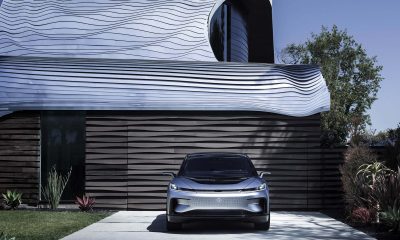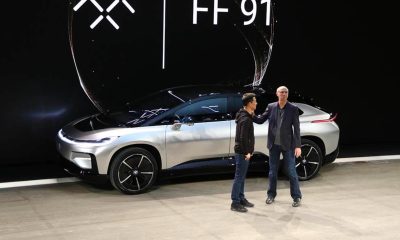News
Faraday Future will live stream its car unveiling on January 3 at 6pm PST
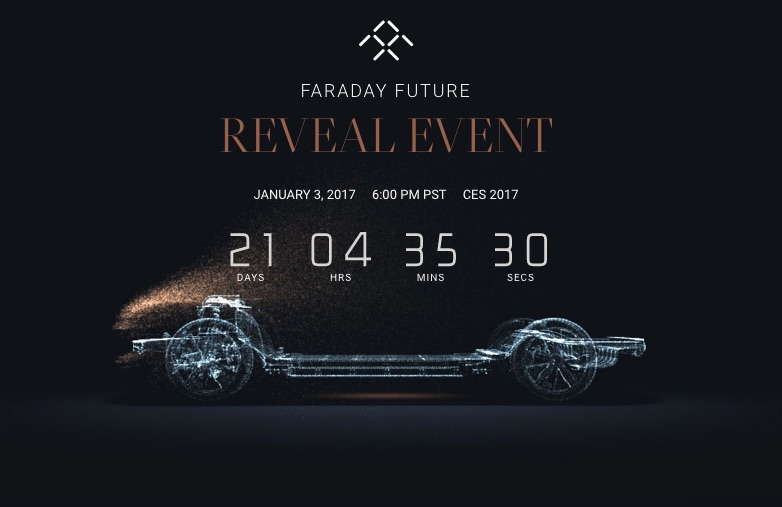
Faraday Future announced that it will live stream the unveiling of its much-talked-about first production car on January 3, 2017 at 6pm PST. The company revealed a newly redesigned website which prominently displays a countdown clock to the unveiling scheduled to take place at CES 2017 in Las Vegas, NV.
The website uses what the company calls particle imagery — a series of points that are combined by computers to represent how the car’s advanced LiDAR scanning and mapping systems view the physical world surrounding the vehicle. The website makes no specific reference to radar. It is well known that Elon Musk is cool to the idea of using LiDAR sensors because of their inability to “see” through fog, rain, snow, and mist.
Between now and the the actual reveal, the website image will add more graphic points to flesh out what the car will look like in silhouette. For the moment, the chassis of the car is viewable to show what the car’s platform looks like.
Anyone interested in information about reserving a Faraday Future automobile may use the Create Account link at the bottom of the home page. Those who create an account will be notified immediately when more information about how to reserve a car comes available. According to a press release from the company, “Both the desktop and mobile sites were developed to share exact functionality and parity between the two. As a mobility company, this parity speaks to FF’s mission to create universal interactivity in the digital space.”
Digging a little deeper into the Faraday Future website, the company says it is “planning to launch a brand new, state-of-the-art automotive production plant” in North Las Vegas “in the very near future.” People familiar with company know that work on that factory has been suspended, reportedly because Faraday Future has run out of money. In fact, Dan Schwartz, treasurer of the state of Nevada, has said publicly that Jia Yueting, the principal financial backer of the company, “[is] out of money. Could he get more money? My sources in China say the government there isn’t financing him. I wonder where and how they’re going to continue this project.”
Last week, Faraday Future renewed its contract with the city of Vallejo, California to explore the feasibility of building a second, smaller factory on North Mare Island in San Francisco Bay. Taking a page from Tesla Motors, Faraday Future is also using videos posted to YouTube to build interest in itself. The most recent video shows the company’s crossover SUV lining up against a Ludicrous Tesla Model X P100D in a drag race. Although the Faraday car is draped in camouflage, it appears to have a shape similar to a crossover or sport utility vehicle. The fact that it is pitted against a Model X contributes to the impression that the Faraday will be an SUV type vehicle.
News
Tesla job listings hint at 24/7 Robotaxi operations in several states
The job opening is active in several regions, including Austin, Palo Alto, Orlando, Tampa, Doral, Houston, Dallas, Tempe, and Las Vegas, as of writing.

Tesla seems to be laying the groundwork for a 24/7 Robotaxi service across several states. This was hinted at by a substantial number of interesting Robotaxi-related job listings that have been posted on the company’s Careers website.
24/7 Robotaxis and Night Shift Specialists
A look at Tesla’s official Careers website shows that the company is currently looking for multiple Robotaxi Fleet Support Specialists for the Night Shift. The listing itself describes a role focused on maintaining vehicles for “smooth 24/7 operations,” hinting at the company’s next steps in its efforts to ramp its autonomous ride-hailing service across several U.S. cities.
“We are looking for a highly motivated and passionate individual to join our Autopilot Fleet Team. As Fleet Support Specialist, you will play a crucial role in ensuring that all our vehicles are in excellent condition at all times, supporting smooth 24/7 vehicle operations,” the job listing read.
The job opening is active in several regions, including Austin, Palo Alto, Orlando, Tampa, Doral, Houston, Dallas, Tempe, and Las Vegas, as of writing. This suggests that Tesla really is looking at a potential multi-state rollout strategy for its Robotaxi service, likely in the near future.
Musk targets major Robotaxi fleet growth by year’s end
Tesla’s Robotaxi pilot is still in early stages, but CEO Elon Musk recently hinted that substantial updates are coming soon to the Austin and Bay Area programs. Speaking on the All-In podcast, Musk said Tesla aims to expand its Robotaxi fleet to 500 vehicles in Austin and 1,000 in the Bay Area before the end of 2025.
“We’re scaling up the number of cars to, what happens if you have a thousand cars? Probably we’ll have a thousands cars or more in the Bay Area by the end of this year, probably 500 or more in the greater Austin area,” Musk said.
With just two months left in the fourth quarter, Tesla’s AI team is facing a busy ramp-up period that could mark the company’s most ambitious real-world test of its autonomous driving program yet.
Energy
Tesla and Samsung SDI in talks over new US battery storage deal: report
The update was related by industry sources and initially reported by South Korean news outlets.

Recent reports have suggested that Tesla and Samsung SDI are in talks over a potential partnership to supply batteries for large-scale energy storage systems (ESS).
The update was related by industry sources and initially reported by South Korean news outlets.
ESS batteries to be built at Samsung’s Indiana plant
As noted in a report from Korea JoongAng Daily, the demand for energy storage systems has been growing rapidly in North America, thanks in no small part to the surge in AI investments across numerous companies. With this in mind, Tesla has reportedly approached Samsung SDI about a potential battery supply deal.
The deal is reportedly worth over 3 trillion Korean won (approximately $2.11 billion) and will span three years, according to The Korea Global Economic Daily. A battery supply deal with Samsung SDI could make sense for Tesla as the company already has a grid-scale battery, the Megapack, which is perfect for industrial use. Samsung SDI could simply supply cells for the EV maker.
Production of the batteries would reportedly take place at Samsung SDI’s joint venture factory with Stellantis in Indiana, which is currently under construction. Samsung SDI recently announced plans to use part of that plant’s EV lines to produce cells for ESS, with a targeted capacity of 30 GWh by the end of next year.
Tesla and Samsung’s partnership
At present, only a handful of manufacturers, including Korea’s LG Energy Solution, Samsung SDI, SK On, and Japan’s Panasonic, are capable of producing energy storage-scale batteries domestically in the United States. A Samsung SDI official issued a comment about the matter, stating, “Nothing has been finalized regarding cooperation with Tesla.”
The possible energy storage system deal adds another layer to Tesla’s growing collaboration with Samsung, which is already in line as a partner in the upcoming production of Tesla’s AI5 and AI6 chips. Early sample manufacturing of the AI6 is expected to begin in South Korea, with mass production slated for Samsung’s Texas-based Taylor foundry when it starts operations.
The AI6 chip will power Tesla’s next wave of high-volume projects, including the Optimus humanoid robot and the autonomous Cybercab service. Musk has called the partnership with Samsung a “real collaboration,” adding that he personally plans to “walk the line” at the Taylor facility to speed up progress.
Elon Musk
Elon Musk maps out Tesla’s AI chip iterations, and they’re pretty nutty
Based on the CEO’s post, it appears that Tesla is already exploring generations as far as AI8.
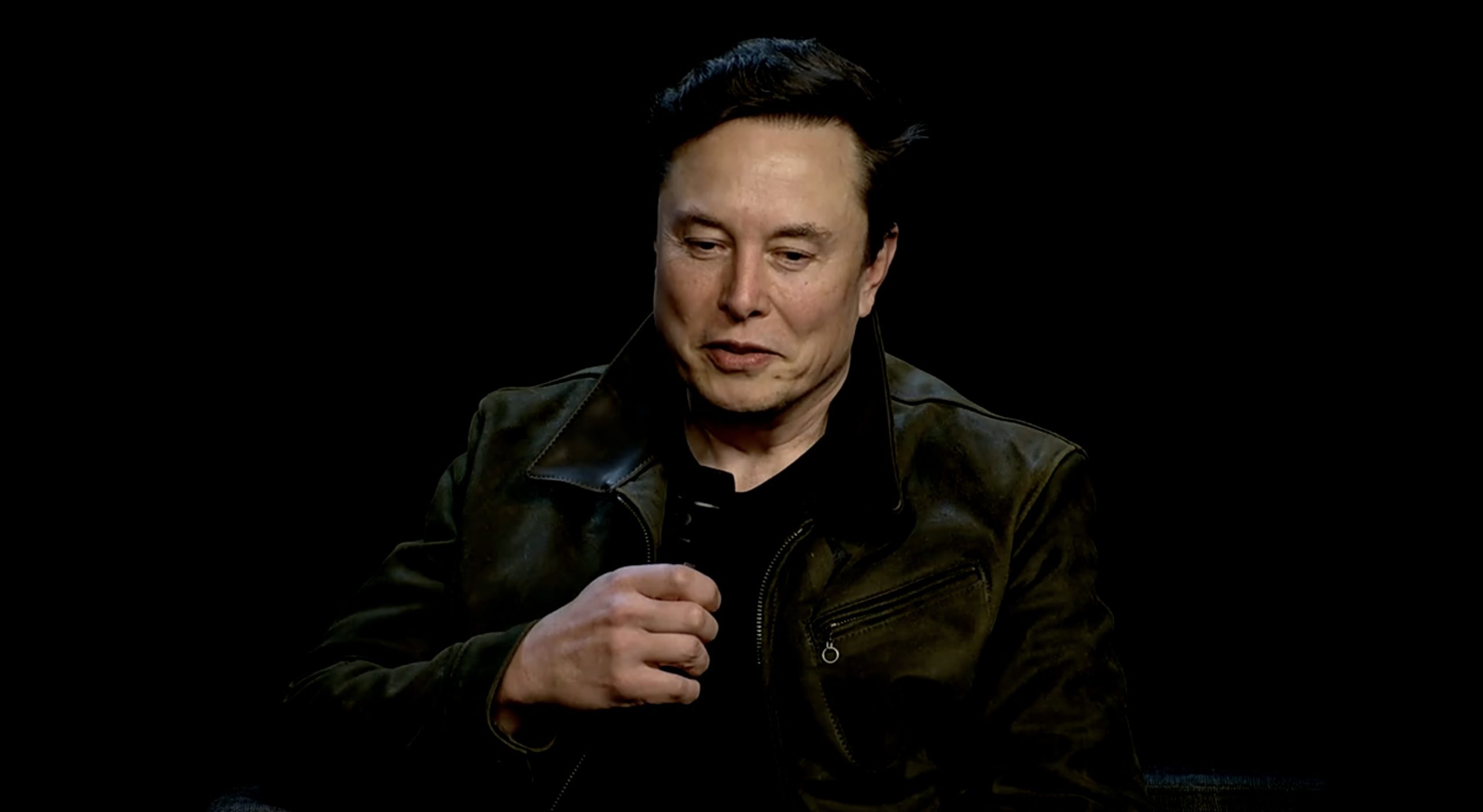
Elon Musk recently revealed new details about Tesla’s next-generation AI5 chip while hinting at even more advanced iterations of its custom silicon.
Based on the CEO’s post, it appears that Tesla is already exploring generations as far ahead as AI8.
Elon Musk teases Tesla’s chip development
In his X post, Musk stated that he had just completed a design review with Tesla’s chip engineers in California and Texas for the company’s upcoming AI5 chip. This was not surprising at all, considering that Musk has been discussing AI5 for quite some time now. What was surprising, however, were his comments that followed.
“And AI6 and AI7 will follow in fast succession. AI8 will be out of this world,” he wrote in his post, adding in a follow-up that his chip design review would be continuing the next day, followed by an Optimus demo review.
Considering that Tesla is currently rolling out a Robotaxi service using cars that are equipped with AI4 chips, some industry watchers have expressed interest in why the company is developing several generations’ worth of silicon for the company’s products. Inasmuch as AI4 might be enough for FSD and the Robotaxi rollout today, however, products such as Optimus might benefit from a more advanced chip.
Even AI5 will already be insanely impressive
During Tesla’s Q3 2025 earnings call, Musk described AI5 as “an amazing design” that represents a full evolution from the AI4 chip currently used in its vehicles and data centers. The new hardware, which will be manufactured by both Samsung in Texas and TSMC in Arizona, is expected to deliver up to 40x performance gains compared to its predecessor.
Tesla’s in-house engineering team redesigned the chip from the ground up, removing traditional components such as GPUs and image signal processors to improve efficiency and power måanagement. Musk said the chip now fits within a half-reticle design, calling it “a beautiful chip” into which he’s “poured so much life energy.”
Musk confirmed Tesla’s plan to create an oversupply of AI5 chips that could power not only vehicles but also humanoid robots and data centers. He emphasized that Tesla’s vertically integrated approach, designing both hardware and software, gives it a unique edge in scaling AI applications.
-
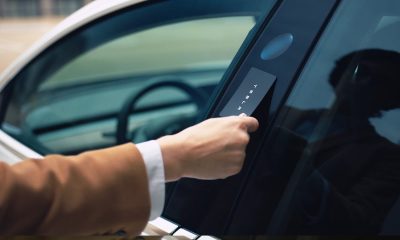
 News2 weeks ago
News2 weeks agoTesla might be doing away with a long-included feature with its vehicles
-
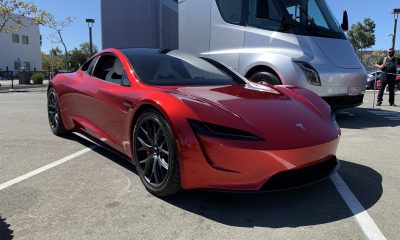
 News2 weeks ago
News2 weeks agoTesla updates fans on its plans for the Roadster
-

 Elon Musk2 weeks ago
Elon Musk2 weeks agoElon Musk: Grok 5 now has a 10% chance of becoming world’s first AGI
-

 News2 weeks ago
News2 weeks agoTesla is ramping up its hiring for the Cybercab production team
-

 News2 weeks ago
News2 weeks agoTesla rolled out a new feature with FSD v14 to fix a major complaint
-
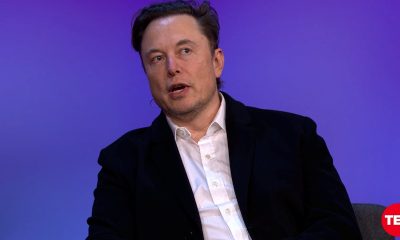
 Elon Musk2 weeks ago
Elon Musk2 weeks agoElon Musk hits back at former Tesla employee who disagrees with pay package
-
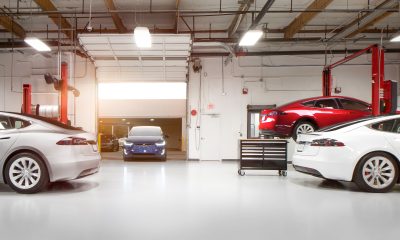
 News2 weeks ago
News2 weeks agoTesla just made Service even easier and more convenient
-

 News2 weeks ago
News2 weeks agoTesla Model Y L becomes China’s 4th best-selling mid-to-large SUV in its first month of sales






